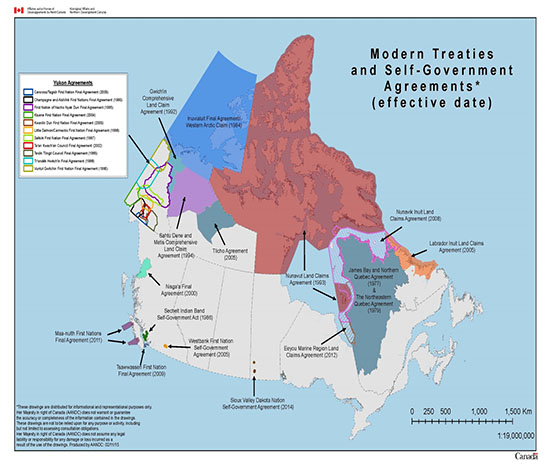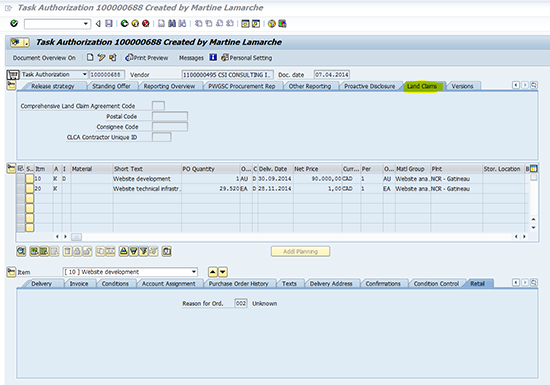ESDC Quick Reference guide for Comprehensive Land Claims Agreements (CLCAs)
printable version (DOCX, 520 KB)
Introduction
Canada has signed 24 Comprehensive Land Claims Agreements (CLCAs) with Aboriginal peoples. CLCAs are modern treaties that are based on the concept of continued Aboriginal rights and title to lands.
Each of the CLCAs contains federal contracting obligations and considerations to support on-going socio-economic development in the CLCA Settlement Areas. This is achieved by increasing the opportunities for Aboriginal peoples to participate and compete successfully for government contracts. Contracting personnel, acquisition card holders and project managers involved in contracting must abide by these obligations.
How do CLCAs affect procurement?
When fulfilling a procurement need which could conceivably involve contracting activity within the boundaries of a CLCA, procurement specialists and acquisition card holders MUST set out to find which CLCAs may apply and what content within the relevant agreement(s) is applicable to their particular requirement.
The final delivery point(s) (location of delivery) of the goods or services performed is the determining factor as to whether the contracting obligations of one (1) or more CLCA(s) apply. The map in annex A identifies the locations of the CLCAs
If necessary separate requirements into commodity or geographic groupings, whenever practical to permit smaller and or more specialized firms to bid.
Once the delivery point is established, review the specific land claim agreement to see if and how it applies to the actual procurement. Land Claim Agreements in effect are described in article 9.35.5 of the Public Services and Procurement Canada (PSPC) Supply Manual.
The use of the CLCA related links found in Annex C may help to identify potential suppliers. This annex contains relevant websites of land claimant groups which may contain business lists, or other contact information such as Tribal council offices.
The following are two examples of procurements possibly impacted by CLCA's:
Example 1
A Service Canada Office in Iqaluit has a requirement for 35 ergonomic chairs, valued at approximately $ 21,000, taxes included. A review of the land claim agreement map indicates that the office is under the Nunavut land claim agreement. The obligations of the Nunavut Land Claim Agreement - July 9, 1993 related to procurement are:
- 24.5.1 Where the Government of Canada or the Territorial Government solicits bids for government contracts to be performed in the Nunavut Settlement Area, it shall ensure that qualified Inuit firms are included in the list of those firms solicited to bid.
- 24.5.2 Where an Inuit firm has previously been awarded a government contract, and has successfully carried out the contract, that Inuit firm shall be included in the solicitation to bid for contracts of a similar nature.
- 24.5.3 In the absence of competitive bidding for government contracts, qualified Inuit firms will be given fair consideration.
The PSPC Supply arrangement for office furniture should not be used as they do not apply in areas under a land claim. Since the government is not soliciting bids for this low dollar value requirement, article 24.5.3 applies. Therefore, in order to satisfy the requirements of the land claim agreement, fair consideration must be given to Inuit vendors who supply goods and services of the type required. Procurement specialists can use Annex C to identify a capable Inuit vendor. Once a vendor is found then as this is a low dollar requirement, an acquisition card may be used as the acquisition and payment tool.
Example 2
A client submits a request for a contract to have a counter built in the local office of Inuvik, North West Territories, and the estimated cost of the project is $21,000, including taxes. The client did not provide a suggested supplier but did provide a detailed scope of work. It may be necessary separate requirements into commodity groupings, counter construction and installations to permit smaller and or more specialized firms to bid.
The first step would be to go to the CLCA map and look up the office to see if it is subject to a land claim. In this case Inuvik is under 2 ratified land claim agreements: Inuvialuit and Gwich'in final agreement.
The next step would be to review the ratified land claim agreements and determine our contracting obligations.
For the Inuvialuit agreement, it is required that a reasonable share of directed and source list contracts be issued to a qualified Inuvialuit contractor. Notification of procurement must be issued to the appropriate claimant groups via fax.
In this case Under the Inuvialuit Agreement, there are two claimant groups: Inuvialuit Development Corporation; and Inuvialuit Regional Corporation: Canada must follow the requirements for notification, first opportunity and/or bid criteria as required by the agreement. See CPN 1997-8 for details.
For the Gwich'in final agreement, there are two first opportunity for procurement requirements: Canada must follow the requirements for notification, first opportunity and/or bid criteria as required by the agreement. See CPN 1997-8 for details.
Being this is a low dollar request and the client has not recommended a vendor, a fax would be sent to the three claimant groups under the two land claims asking them if they have any firms that would be interested in this requirement by giving them a reasonable time to respond. In this case, 5 days should be reasonable as it is a low dollar value requirement. Based on the interested claimant group’s contractor’s responses, we can then proceed with normal contracting practices to determine best value for the crown and issue the contract.
Support for Contracting and Project Authorities
For further ESDC guidance, visit the page: "Procurement: Legislation, Policies and Other Useful Links".
See Chapter 9.35 Comprehensive Land Claims Agreements of the PSPC Supply Manual which contains general information about CLCAs, overviews and related links for each agreement. Clients are encouraged to review 9.35.25 of this section when developing their requirements definition for competitive procurements impacted by CLCAs.
Reporting CLCA contracting in myEMS (SAP)
To capture CLCA contracting data when entering a contract into ESDC's financial system (myEMS), the procurement specialist must complete the four boxes in the display screen under the header information. See Annex B for a screenshot of the applicable page. This is a requirement when a vendor will be delivering a good or service to a CLCA area.
For acquisition cards buys directed to CLCA vendors, please report these via the procurement portal at nc-purchasing_portal@hrsdc-rhdcc.gc.ca . The reporting Excel template can be requested at this address.
Annex A
CLCAs are located in British Columbia (3), Yukon (11), Northwest Territories (4), Nunavut (1), Quebec (4) and Labrador (1)
click on the image below for a larger view
Annex B
click on the image below for a larger view

